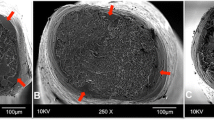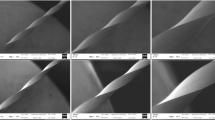Abstract
Objectives
The aim of this study was to evaluate the impact of body temperature on the cyclic fatigue resistance of different NiTi alloys used for the manufacturing of Reciproc Blue R25 (RB 25.08; VDW, Munich, Germany), X1 Blue File 25 (X1 25.06; MK Life Medical and Dental Products, Porto Alegre, Brazil) and WaveOne Gold Primary (WOG 25.07; Dentsply Maillefer, Ballaigues, Switzerland).
Materials and methods
Sixty instruments of the RB 25.08, X1 25.06 and WOG 25.07 systems were used (n = 20). Cyclic fatigue tests were performed at room temperature (20° ± 1 °C) and at body temperature (37° ± 1 °C). The instruments were reciprocated until fracture occurred in an artificial stainless steel canal with a 60° angle and a 5-mm radius of curvature. The time to fracture (TTF) was recorded. Also, the number of cycles to fracture (NCF) was calculated. Data were analysed using one-way ANOVA and Tukey’s tests for inter-group comparison at both temperatures and for the reduction of cyclic fatigue at body temperature. For intra-group comparison at the different temperatures, the unpaired t test was used.
Results
The cyclic fatigue test at 20 °C showed that RB 25.08 and X1 25.06 presented significantly higher TTF and NCF than WOG 25.07 (P < 0.05). At 37 °C, all groups presented significant reduction of TTF and NCF (P < 0.05). RB 25.08 presented significant higher TTF than WOG 25.07 (P < 0.05). Regarding the NCF, there was no significant difference among the groups (P > 0.05). The WOG 25.07 presented the lowest percentage reduction of cyclic fatigue (P < 0.05).
Conclusion
The body temperature treatment caused a marked reduction of the cyclic fatigue resistance for all reciprocating instruments tested. The RB 25.08 and X1 25.06 systems presented similar results at both temperatures tested. However, WOG 25.07 presented the lowest percentage reduction in fatigue resistance at body temperature.
Clinical relevance
The cyclic fatigue resistance of NiTi reciprocating instruments has been evaluated at room temperature. However, the fatigue resistance significantly decreases upon exposure to body temperature, which could affect the mechanical behaviour of the NiTi instruments during root canal preparation.


Similar content being viewed by others
References
Shen Y, Zhou HM, Zheng YF, Peng B, Haapasalo M (2013) Current challenges and concepts of the thermomechanical treatment of nickel-titanium instruments. J Endod 39(2):163–172
Pereira ES, Peixoto IF, Viana AC et al (2012) Physical and mechanical properties of a thermomechanically treated NiTi wire used in the manufacture of rotary endodontic instruments. Int Endod J 45(5):469–474
Kuhn G, Jordan L (2002) Fatigue and mechanical properties of nickel-titanium endodontic instruments. J Endod 28(1):716–720
De-Deus G, Silva EJ, Vieira VT et al (2017) Blue thermomechanical treatment optimizes fatigue resistance and flexibility of the Reciproc files. J Endod 43(3):462–466
Topçuoğlu HS, Düzgün S, Aktı A, Topçuoğlu G (2017) Laboratory comparison of cyclic fatigue resistance of WaveOne Gold, Reciproc and WaveOne files in canals with a double curvature. Int Endod J 50(7):713–717
Gao Y, Gutmann JL, Wilkinson K, Maxwell R, Ammon D (2012) Evaluation of the impact of raw materials on the fatigue and mechanical properties of ProFile Vortex rotary instruments. J Endod 38(3):398–401
Kaval ME, Capar ID, Ertas H (2017) Evaluation of the cyclic fatigue and torsional resistance of novel nickel-titanium rotary files with various alloy properties. J Endod 42(12):1840–1843
Gambarini G, Grande NM, Plotino G, Somma F, Garala M, de Luca M, Testarelli L (2008) Fatigue resistance of engine-driven rotary nickel-titanium instruments produced by new manufacturing methods. J Endod 34(8):1003–1005
Hieawy A, Haapasalo M, Zhou H, Wang ZJ, Shen Y (2015) Phase transformation behavior and resistance to bending and cyclic fatigue of ProTaper Gold and ProTaper Universal instruments. J Endod 41(7):1134–1138
Drexel M, Selvaduray G, Pelton A (2007) The effects of cold work and heat treatment on the properties of nitinol wire. In: Medical Device Materials IV: Proceedings from the Materials and Processes for Medical Devices Conference. ASM International, Materials Park, pp 114–119
Kim HC, Kwak SW, Cheung GS et al (2012) Cyclic fatigue and torsional resistance of two new nickel-titanium instruments used in reciprocation motion: Reciproc versus WaveOne. J Endod 38(4):541–544
De-Deus G, Moreira EJL, Lopes HP et al (2010) Extended cyclic fatigue life of F2 ProTaper instruments used in reciprocating movement. Int Endod 43(12):1063–1068
Karataş E, Arslan H, Büker M et al (2017) Effect of movement kinematics on the cyclic fatigue resistance of nickel-titanium instruments. Int Endod J 49(4):361–364
Silva EJ, Rodrigues C, Vieira VT et al (2016) Bending resistance and cyclic fatigue of a new heat-treated reciprocating instrument. Scanning 38(6):837–841
Alcalde MP, Duarte MAH, Bramante CM et al (2017) Cyclic fatigue and torsional strength of three different thermally treated reciprocating nickel-titanium instruments. Clin Oral Investig 22(4):1865–1871
Gündoğar M, Özyürek T (2017) Cyclic fatigue resistance of OneShape, HyFlex EDM, WaveOne Gold, and Reciproc Blue nickel-titanium instruments. J Endod 43(7):1192–1196
Keskin C, Inan U, Demiral M, Keleş A (2017) Cyclic fatigue resistance of Reciproc Blue, Reciproc, and WaveOne Gold reciprocating instruments. J Endod 43(8):1360–1363
Dosanjh A, Paurazas S, Askar M (2017) The effect of temperature on cyclic fatigue of nickel-titanium rotary endodontic instruments. J Endod 43(5):823–826
de Vasconcelos RA, Murphy S, Carvalho CA et al (2016) Evidence for reduced fatigue resistance of contemporary rotary instruments exposed to body temperature. J Endod 42(5):782–787
Jamleh A, Yahata Y, Ebihara A, Atmeh AR, Bakhsh T, Suda H (2016) Performance of NiTi endodontic instrument under different temperatures. Odontology 104(6):324–328
McKelvey AL, Ritchie RO (1999) Fatigue-crack propagation in Nitinol, a shape-memory and superelastic endovascular stent material. J Biomed Mater Res 47(3):301–308
Cheung GS, Darvell BW (2007) Fatigue testing of a NiTi rotary instrument. Part 1: strain-life relationship. Int Endod J 40(8):612–618
Cunningham WT, Balekjian AY (1980) Effect of temperature on collagen-dissolving ability of sodium hypochlorite endodontic irrigant. Oral Surg Oral Med Oral Pathol 49(2):175–177
de Hemptinne F, Slaus G, Vandendael M, Jacquet W, de Moor RJ, Bottenberg P (2015) In vivo intracanal temperature evolution during endodontic treatment after the injection of room temperature or preheated sodium hypochlorite. J Endod 41(7):1112–1115
Capar ID, Kaval ME, Ertas H, Sen BH (2015) Comparison of the cyclic fatigue resistance of 5 different rotary pathfinding instruments made of conventional nickel-titanium wire, M-wire and controlled memory wire. J Endod 41(4):535–538
Plotino G, Grande NM, Cordaro M, Testarelli L, Gambarini G (2009) A review of cyclic fatigue testing of nickel titanium rotary instruments. J Endod 35(11):1469–1476
Karatas E, Arslan H, Buker M et al (2016) Effect of movement kinematics on the cyclic fatigue resistance of nickel-titanium instruments. Int Endod J 49(4):361–364
Lopes HP, Ferreira AA, Elias CN, Moreira EJ et al (2009) Influence of rotational speed on the cyclic fatigue resistance of rotary nickel-titanium endodontic instruments. J Endod 35(7):1013–1016
Sattapan B, Nervo GJ, Palamara JEA et al (2000) Defects in rotary nickel–titanium files after clinical use. J Endod 26(3):161–165. 23
Funding
This study is supported by FAPESP/BRAZIL (grant no. 2014/25520-0).
Author information
Authors and Affiliations
Corresponding author
Ethics declarations
Conflict of interest
The authors declare that they have no conflicts of interest.
Ethical approval
This article does not contain any studies with human participants or animals performed by any of the authors.
Informed consent
For this type of study, formal consent is not required.
Rights and permissions
About this article
Cite this article
Klymus, M.E., Alcalde, M.P., Vivan, R.R. et al. Effect of temperature on the cyclic fatigue resistance of thermally treated reciprocating instruments. Clin Oral Invest 23, 3047–3052 (2019). https://doi.org/10.1007/s00784-018-2718-1
Received:
Accepted:
Published:
Issue Date:
DOI: https://doi.org/10.1007/s00784-018-2718-1




